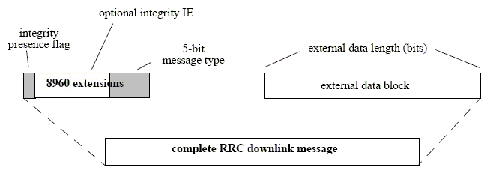RRC Pipe
Last updated: January 14, 2010
This section is only applicable to the lab application.
RRC Pipe Overview
The RRC pipe mechanism allows you to send and receive RRC messages and/or message contents, that are not explicitly supported (or only partially supported) by the test set. When the pipe is enabled, you can externally encode specified RRC messages and deliver them to the UE using the test set. In addition, certain messages can also be received from the UE and made available to you for querying over the remote user interface (subject to any conditions that are specific to each message).
The test set supports Assisted GPS (A-GPS) by using the RRC Pipe to transport externally coded messages to and from the UE.
The RRC pipe can only be used when an RRC connection is active, and when CALL:PPRocedure:RRC:PIPE[:STATe] is set to "On". If a request to send data is received when either of these conditions is not met, the request will be ignored.Similiarly, if UE data corresponding to a message that would normally be delivered to you using the RRC pipe is received, but CALL:PPRocedure:RRC:PIPE[:STATe] is set to "Off", the messages will be handled as normal by the protocol stack, but then discarded without making the data available on the uplink RRC pipe.The maximum length of the RRC pipe data block passed either to or from the user over the remote user interface is 1000 bytes.
Downlink RRC Pipe Data Format
All downlink RRC Pipe messages should adhere to the following requirements:
- The message should consist of a data block (hex character string) and a length field describing the number of relevant bits in the data block, beginning with the most significant bit of the first hex character.
- The data block should not include the following fields. These will be added by the test set if required:
This means that the first bit of the data block should represent the bit that will immediately follow the 5-bit message type in the completed message. The message structure is illustrated in the following graphic.
RRC Pipe Parameters
This section is only applicable to the lab application.
-
RRC Pipe State
This parameter sets the state of the RRC Pipe. When set to On, external data received for downlink transmission over the RRC pipe is processed according to the requirements of the specific message. When set to Off, the message is ignored.
GPIB command: CALL:PPRocedure:RRC:PIPE[:STATe]
-
Measurement Control Message
This parameter sets the the measurement identity, length (in bits), and the contents of the Measurement Control Message. If the Measurement Control Message is received while CALL:PPRocedure:RRC:PIPE[:STATe] is set to On and an RRC connection is present, the test set adds the appropriate message type parameter and integrity information if applicable. The resulting message is sent to the UE. Otherwise the message is ignored.
GPIB command: CALL:PPRocedure:RRC:PIPE:MCMessage[:DATA]
-
Assistance Data Delivery Message
This parameter sets the length (in bits) and the contents of the Assistance Data Delivery Message. If the Assistance Data Delivery Message is received while CALL:PPRocedure:RRC:PIPE[:STATe] is set to On and an RRC connection is present, the test set adds the appropriate message type parameter and integrity information if applicable, and sends the resulting message to the UE. Otherwise the message is ignored.
GPIB command: CALL:PPRocedure:RRC:PIPE:ADDMessage[:DATA]
-
Measurement Control Message (MCM) Response
This result provides Measurement Report and Measurement Control Failure messages received from the UE. Typically these messages will be sent by the UE in response to Measurement Control messages sent over the downlink RRC pipe.
GPIB command: CALL:PPRocedure:RRC:PIPE:MCMessage:RESPonse[:DATA]?
-
Measurement Control Message (MCM) Response Clear
This action performs a Measurement Control Message (MCM) Response Clear event. This event removes all stored messages from the MCM response buffer. When the event is received all the stored messages are discarded and the buffer is emptied.
GPIB command: CALL:PPRocedure:RRC:PIPE:MCMessage:RESPonse:CLEar
